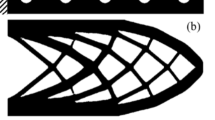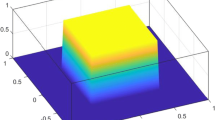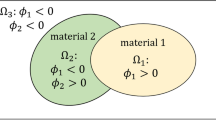Abstract
This paper presents a method to locally constrain multiple material volume domains for structural optimization with the Level Set Method (LSM). Two different Lagrangian formulations and multiplier update methods are used, for both the global and local problem. The local volume domains can be constrained by both equality and inequality constraints. The optimization objective is compliance minimization for well-posed statically loaded structures. For validation, several example problems are established and solved using the proposed method. Results show that the volume ratios for user established sub-domains can be controlled successfully. The local constraint values are met accurately in the case of equality constraints and remain in their feasible domain in the case of inequality constraints. Optimization results are not significantly hindered by the introduction of local volume constraints for comparable problems.














Similar content being viewed by others
References
Allaire G, Jouve F (2008) Minimum stress optimal design with the level set method. Eng Anal Bound Elem 32(11):909–918
Allaire G, Jouve F, Toader AM (2002) A level-set method for shape optimization. Comptes Rendus Mathé,matique 334(12):1125–1130
Allaire G, Jouve F, Toader AM (2004) Structural optimization using sensitivity analysis and a level-set method. J Comput Phys 194(1):363–393
Allaire G, Gournay FD, Jouve F, Toader AM (2005) Structural optimization using topological and shape sensitivity via a level set method. Control Cybern 34(1):59–80
Arora J (2012) Introduction to optimum design. Academic Press
Bendsøe MP, Sigmund O (1999) Material interpolation schemes in topology optimization. Arch Appl Mech 69(9-10):635–654
Bruggi M, Duysinx P (2012) Topology optimization for minimum weight with compliance and stress constraints. Struct Multidiscip Optim 46(3):369–384
Challis VJ (2010) A discrete level-set topology optimization code written in Matlab. Struct Multidiscip Optim 41(3):453–464
De Ruiter M, Van Keulen F (2000) Topology optimization: approaching the material distribution problem using a topological function description. In: International conference on engineering computational technology, pp 111–119
De Ruiter MJ, Van Keulen F (2004) Topology optimization using a topology description function. Struct Multidiscip Optim 26(6):406–416
dHondt G, Wittig K (2016) CalculiX User’s Guide. MTU
Duddeck F (2008) Multidisciplinary optimization of car bodies. Struct Multidiscip Optim 35(4):375–389
Duysinx P, Bendsøe MP (1998) Topology optimization of continuum structures with local stress constraints. Int J Numer Methods Eng 43(8):1453–1478
Hesse SH, Lukaszewicz DHJA, Duddeck F (2015) A method to reduce design complexity of automotive composite structures with respect to crashworthiness. Compos Struct 129:236–249
James KA, Lee E, Martins JRRA (2012) Stress-based topology optimization using an isoparametric level set method. Finite Elem Anal Des 58:20–30
Kawamoto A, Matsumori T, Yamasaki S, Nomura T, Kondoh T, Nishiwaki S (2011) Heaviside projection based topology optimization by a PDE-filtered scalar function. Struct Multidiscip Optim 44(1):19–24
Kreissl S (2011) Topology optimization of flow problems modeled by the incompressible Navier-Stokes equations. Ph.D. thesis, University of Colorado Boulder
Le C, Norato J, Bruns T, Ha C, Tortorelli D (2010) Stress-based topology optimization for continua. Struct Multidiscip Optim 41(4):605–620
Luo Z, Wang MY, Wang S, Wei P (2008a) A level set-based parameterization method for structural shape and topology optimization. Int J Numer Methods Eng 76(1):1–26
Luo J, Luo Z, Chen L, Tong L, Wang MY (2008b) A semi-implicit level set method for structural shape and topology optimization. J Comput Phys 227:5561–5581
Osher SJ, Santosa F (2001) Level set methods for optimization problems involving geometry and constraints: I. Frequencies of a two-density inhomogeneous drum. J Comput Phys 171(1):272–288
Osher S, Sethian JA (1988) fronts propagating with curvature-dependent speed: algorithms based on Hamilton-Jacobi formulations. J Comput Phys 79:12–49
Otomori M, Yamada T, Izui K, Nishiwaki S (2011) Topology optimization based on the level set method using mathematical programming. Trans Jpn Soc Mech Eng Series C 77:4001–4014
Otomori M, Yamada T, Izui K, Nishiwaki S (2014) Matlab code for a level set-based topology optimization method using a reaction diffusion equation. Struct Multidiscip Optim 51(5):1159–1172
Paris J, Navarrina F, Colominas I, Casteleiro M (2009) Topology optimization of continuum structures with local and global stress constraints. Struct Multidiscip Optim 39(4):419–437
Sethian J, Wiegmann A (2000) Structural boundary design via level set and immersed interface methods. J Comput Phys 163(2):489–528
van Dijk N, Langelaar M, Van Keulen F (2012) Explicit level-set-based topology optimization using an exact Heaviside function and consistent sensitivity analysis. Int J Numer Methods Eng 91(1):67–97
van Dijk N P, Maute K, Langelaar M, Van keulen F (2013) Level-set methods for structural topology optimization: a review. Struct Multidiscip Optim 48(3):437–472
Van Miegroet L, Duysinx P (2007) Stress concentration minimization of 2D filets using x-FEM and level set description. Struct Multidiscip Optim 33(4-5):425–438
Wang S, Wang MY (2006) Radial basis functions and level set method for structural topology optimization. Int J Numer Methods Eng 65(12):2060–2090
Wang MY, Wang X, Guo D (2003) A level set method for structural topology optimization. Comput Methods Appl Mech Eng 192(1–2):227–246
Yamasaki S, Nishiwaki S, Yamada T, Izui K, Yoshimura M (2010) A structural optimization method based on the level set method using a new geometry-based re-initialization scheme. Int J Numer Methods Eng 83 (12):1580–1624
Yamasaki S, Nomura T, Kawamoto A, Sato K, Nishiwaki S (2011) A level set-based topology optimization method targeting metallic waveguide design problems. Int J Numer Methods Eng 87(9):844–868
Yang RJ, Chen CJ (1996) Stress-based topology optimization. Struct Multidiscip Optim 12(2):98–105
Zhou M, Rozvany G (1991) The coc algorithm, part ii: topological, geometrical and generalized shape optimization. Comput Methods Appl Mech Eng 89(1):309–336
Acknowledgements
The authors would like to express their gratitude to BMW Group to carry out and publish this research.
Author information
Authors and Affiliations
Corresponding author
Appendix: Derivatives
Appendix: Derivatives
The Lagrangian \(\mathcal {L}\) is derived in order to transform the inequality constrained optimization problem into an unconstrained problem:
where s is a slack variable which converts the inequality into an equality constraint. The optimum is defined by meeting the KKT optimality conditions.
Let us take the compliance equal to the total strain energy:
The stiffness matrix \(\tilde {\mathbf {K}}(\mathbf {\rho })\) is determined as follows:
where \(\bigcup \) denotes the assembly of element components, N e is the total number of elements, K e is the element stiffness matrix and ρ e is the element density determined by the LSF values. The strain energy density can be determined as follows:
The shape derivative of the Lagrangian \(\mathcal {L}\) is derived as the Fréchet derivative with respect to ϕ as follows:
where ψ is the variation of the level set function such that ψ ∈ Ψ. Combining (42) and (46), we get:
1.1 A.1 Shape derivative of the compliance
Now let us define the shape derivative of the strain energy density as the Fréchet derivative with respect to ϕ:
Now by rule of total derivative, (48) can be rewritten as follows:
The partial derivatives from (49) are derived as follows:
The Fréchet derivatives for the condition \(\tilde {\mathbf {K}} \mathbf {u} - \mathbf {f}^{\text {ext}} = 0\) are as follows:
where \(\mathbf {a} = \tilde {\mathbf {K}} \mathbf {u}\). The partial derivatives from (51) are derived as follows:
From combining (51) and (52) follows:
Now combining (49) and (50) and substituting (53), we get the following:
This leads to the following relation for the shape derivative of the strain energy density:
1.2 A.2 Shape derivative of the global volume constraint
The derivation of the shape derivative of the Volume constraint follows the same procedure as with the compliance. The volume V is expressed as follows:
The shape derivative of the constraint g(ϕ(x)) is derived as follows:
This leads to the following definition of the constraint shape derivative:
1.3 A.3 Shape derivative of the Lagrangian
The shape derivative of the Lagrangian can now be defined by substituting the results from (55) and (58) into (47) and taking the derivative with respect to the LSF values:
The boundary normal velocity V N (x, t) can now be defined as:
The Lagrangian formulation of the optimization problem contains a slack variable s to account for the inequality constraint. The switching condition from the KKT conditions can be satisfied in two ways:
-
λ = 0: This implies that the inequality condition is inactive, meaning that the suggested optimum features a lower volume fraction than \(V_{\max }\). However, for problems with fixed boundary conditions and fixed loads, not considering body forces, the compliance is minimized when the design domain is completely filled with material. This fact makes this case physically irrelevant.
-
s = 0: Zero slack implies an active inequality constraint, g(ϕ) = 0, indicating that \(V(\phi ) = V_{\max }\) for the optimum solution.
These cases show that the optimum will always lie at \(V(\phi ) = V_{\max }\). As a result of this, one could define the volume constraint in (21) as an equality constraint. The slack variable s is now redundant and omitted.
Rights and permissions
About this article
Cite this article
Hesse, S.H., Leidinger, L.F., Kremheller, J. et al. Shape optimization with the level-set-method using local volume constraints. Struct Multidisc Optim 57, 115–130 (2018). https://doi.org/10.1007/s00158-017-1741-1
Received:
Revised:
Accepted:
Published:
Issue Date:
DOI: https://doi.org/10.1007/s00158-017-1741-1




